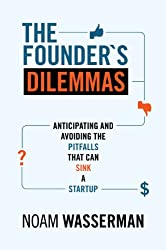
Rating: 8.3/10.
The Cold Start Problem: How to Start and Scale Network Effects by Andrew Chen
Book about the dynamics of network effects and offers guidance for founders who are building products that depend on these effects for success. The author previously worked at Uber during a phase of explosive growth where he witnessed firsthand the development of local networks of drivers and riders. Later, while at the venture capital firm Andreessen Horowitz (a16z), he observed numerous founders who led companies leveraging network effects.
Network effects are when a product becomes more valuable as more users join; the classic example is the telephone, which is virtually useless if nobody else is available to answer a call. Despite the technology often being straightforward to construct, creating a product with network effects that can ward off competition is extremely challenging.
There are parallels between network effects and population dynamics in ecology, there is a tipping point: below it, a product fails to provide sufficient value, leading users to abandon it, eventually reducing the user base to zero. Once above this tipping point, the product becomes viable, but there’s a limit to its growth. Beyond a certain saturation point, additional value diminishes—for instance, with Uber, a decrease in wait time from 15 minutes to under 5 minutes is significant, but further reducing the wait time yields negligible benefits. After the tipping point, a product likely experiences rapid growth until it reaches a ceiling, at which point growth plateaus, and the network itself becomes a defensive moat against competitors.
An example is Slack, which originated as a lackluster gaming company named Tiny Speck. After a couple of unremarkable launches, they pivoted to adapt their internal chat tool for broader use, essentially creating a user-friendly layer over IRC, which many found cumbersome. Slack rapidly benefitted from network effects as more companies began to use it. The value for Slack emerged quickly once teams started using it, which proved to be more beneficial than having a scattered group of disconnected individuals on the platform. Thus, for a product to succeed, it’s crucial to identify the different network thresholds needed to become valuable and to reach that point as quickly as possible.
Bootstrapping a network is challenging, and the most effective strategy often involves starting with a small, focused network—either within a niche or a confined geographic area—as opposed to the same number of users spread out with no connections to one another. Tinder started by hosting college parties and making everyone download the app to enter, gaining a few hundred users at a time from the same school, eventually reaching a tipping point when further users start to join organically. The localized dynamics help make the network viable, and once it’s successful in one area, you can replicate the approach in new areas by following a similar playbook.
Networks typically have a ‘hard’ side, which requires more effort, and an ‘easy’ side, often the consumer. On many platforms, a small proportion of users on the hard side contribute most of the content; for example, in Wikipedia, only a few thousand individuals write nearly all the articles. Therefore, it’s crucial to prioritize attracting and retaining these key contributors. In the case of Tinder, the hard side was attractive women, who needed a way to filter out messages and not be overwhelmed. Addressing this was central to Tinder’s value proposition. A common strategy is paying money for the hard side to join, eg: Uber paid drivers in a new city a minimum rate while riders were low, after the network is going then worry about the unit economics later.
Networks often get started when new technology enables something that wasn’t possible before, resulting in a product that outperforms its competitors and attracts people to join. It’s a good idea to make the product free to join and start charging only after users have derived some value from it; for example, Zoom charges only for calls longer than 40 minutes. Another strategy is to create a tool that’s useful on its own but becomes even more valuable with a network—like Instagram, which was handy as a photo filter app before the sharing features were added, ensuring that it still provided value even without a network.
When both the network and product function well, this is referred to as a “Magic Moment,” where everything operates as expected. Conversely, what you want to avoid is a “Zero Moment,” when a user opens an app to find it empty, making it likely they’ll never return.
Advantages of an invite-only approach in early stages: it ensures that every new user already has a connection through the person who invited them; well-connected individuals, who are valuable to the network, tend to be invited first; it allows the backend to scale up gradually; and it enables the team to manually curate the initial network. Sometimes manual work is needed before the network becomes self-sustaining, as demonstrated when the Reddit founders posted numerous links manually in the early days, or when Nintendo created many first-party games for the Switch console before third-party developers were willing to invest in it.
After the initial phase comes the growth phase, where the startup focuses on improving monetization, user retention, and continued growth. Dropbox, for instance, started as a consumer-oriented product but pivoted to prioritize features for business customers after realizing that they were more valuable.
Growth typically involves a lot of A/B testing to enhance retention; at each step, you identify a user segment and figure out how to increase their engagement, which often varies across user types. For example, leveraging the existing network to re-engage users who have churned is quite different from the early stages where growth simply meant acquiring new users. You need to take many small steps to improve the viral coefficient by encouraging sharing or friend referrals, depending on the product. Moreover, enhancing retention is crucial for the long-term viability of the product. The upside of growth is that as the network expands, the unit economics tend to become more favorable, and efficiency increases, so there’s less need to subsidize it.
To reach a successful stage, a startup needs to grow to about $100 million in ARR, which means achieving strong product-market fit and then doubling in size six or seven times over a few years. Consequently, there is immense pressure to grow, and any signs that growth is slowing are taken as a bad sign. Twitch, for instance, began with various streaming categories but hit a plateau, leading to questions about how to continue growing. Their solution was to focus on gaming, particularly developing features useful for streamers. When a product hits a saturation stage, it needs to simultaneously try lots of things to break past this ceiling. This means assembling hundreds of teams to innovate, expanding into new demographics and regions, and developing new product lines. Adapting to new demographics or regions involves tailoring features to meet specific needs, such as the Uber app offering motorcycle rides and cash payments in developing countries instead of credit card transactions.
At the saturation point, other challenges arise: marketing channels tend to become less effective over time as customers learn to ignore ads, and the ROI diminishes, slowing growth. Thus, startups must rely more on network effects for growth rather than on paid marketing. Acquiring new users becomes increasingly expensive; for example, there comes a point where everyone interested in driving for Uber has already signed up, making it impossible to simply sign up more drivers. The strategy then shifts to professionalizing drivers, turning them from part-time or hobbyists into full-time, with efficient operations, though this can alienate many.
As the network grows, investment in moderation is crucial to combat unwanted behaviors like spam and scams. Usually this is done with a mix of community-based human moderation and software features that support these moderators. Otherwise, valuable users may leave, as seen with Usenet, one of the earliest online communities, which struggled with spam due to a lack of resources. Also, when a network is mature, older incumbents tend to gain an unfair advantage over newcomers. Advanced algorithms to recommend quality content become necessary, like in YouTube; without them, the oldest users become entrenched, making it challenging for new users to gain visibility.
The last section of the book discusses the dynamics at play when a startup challenges an incumbent player. It’s often assumed that large, established players are invincible due to network effects, which tend to compound over time. However, startups have the advantage of being able to focus on a niche market and execute quickly, unlike their larger counterparts who must defend every potential point of entry. Startups can target just one weak point of the incumbent; for instance, Airbnb found a niche in Craigslist’s short-term rental listings, which didn’t function very well, and once they dominated that niche, it became difficult for the incumbent to reclaim it.
Large players have substantial resources and often opt for a ‘big bang’ launch to quickly attract a large user base, like Google Plus. However, this isn’t always the best approach because it can result in a weak network. A more effective strategy is to start small, secure a niche, and then expand gradually, ensuring that at every stage the network is delivering real value to its users. Bundling is another tactic, where an existing network or product is used to promote a new one, such as Microsoft Windows bundling its browser with the operating system. Yet, this often fails, particularly if the new product is inferior or the necessary network effects are absent, meaning default status alone isn’t enough.
For instance, a European short-term rental startup called Wimdu tried to scale faster than Airbnb and posed a significant threat, but they compromised on quality of listings and customer experience for quantity and eventually collapsed within a few years. Uber was effective at eliminating competition in the ride-sharing market by waging an intense battle for drivers. They used semi-legal methods for intelligence gathering on competitors and promotions to discourage drivers from using multiple apps, leveraging their size for economic efficiency to drive less financially robust competitors out of the market.
Overall, this book is a great overview of networks effects in many B2C products and two-sided marketplaces, which often depend heavily on network effects. The examples cited are among the most well-known startups, so this is essential reading for anyone considering launching a product in this domain.



